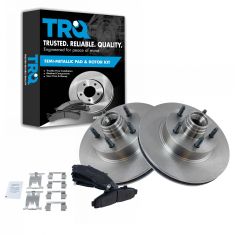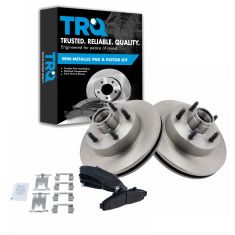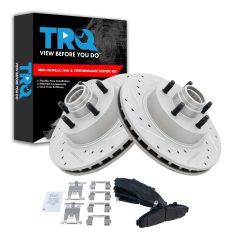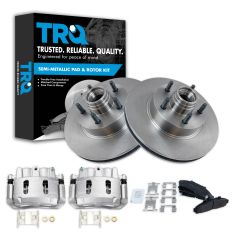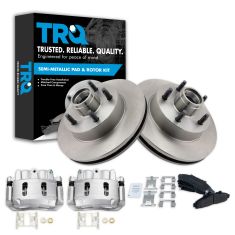Replaces
2001 Mazda B2300 Truck Front Semi-Metallic Brake Pads TRQ BFA73563
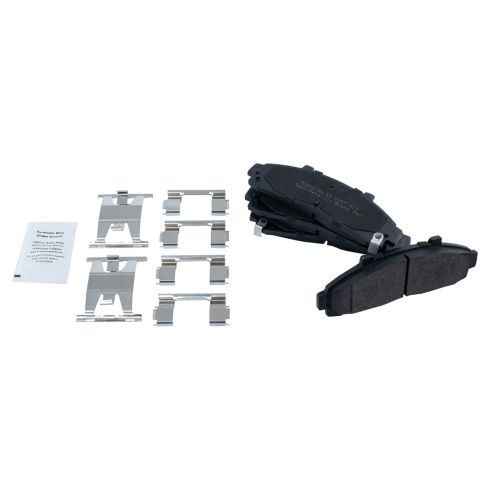


BFA73563
In Stock
This part doesn’t fit a . Select from parts that fit.
Specify your vehicle's year, make and model to guarantee fit.
Orders must be placed by 2pm ET

Part Details
- Brake Pad Bonding Type: Premium Posi
-
Includes:
Contact Point Grease
Hardware - Brake Pad Friction Material: Semi-Metallic
Specification
- Front
Product Features
TRQ brake pads are manufactured using premium raw materials and design standards to restore original performance. TRQ brake pads are positive molded and utilize a multi-layer shim for enhanced performance and service life. TRQ’s combination of materials and design ensures a low dust and low noise braking experience. TRQ recommends replacing your brake rotors when you replace your brake pads to ensure even wear of components and improved braking comfort. All products are fit and road-tested in our Massachusetts R&D facility to ensure we deliver on our promise of Trusted Reliable Quality.
Item Condition:
New
Attention California Customers:
![]() WARNING: This product can expose you to chemicals including Lead and Lead Compounds, which are known to the State of California to cause cancer, and birth defects or other reproductive harm. For more information, go to www.P65Warnings.ca.gov.
WARNING: This product can expose you to chemicals including Lead and Lead Compounds, which are known to the State of California to cause cancer, and birth defects or other reproductive harm. For more information, go to www.P65Warnings.ca.gov.
Lifetime Warranty
This item is backed by our limited lifetime warranty. In the event that this item should fail due to manufacturing defects during intended use, we will replace the part free of charge. This warranty covers the cost of the part only.
FREE Shipping is standard on Orders shipped to the lower 48 States (Contiguous United States). Standard shipping charges apply to Hawaii, Alaska and US Territories. Shipping is not available to Canada.
Expedited is available on checkout to the United States, excluding Alaska, Hawaii and US Territories as well as P.O. Boxes and APO/FPO/DPO addresses. Final shipping costs are available at checkout.



Created on:
Tools used
- While your car is still on the ground, use your 21mm socket to loosen your lug nuts. Jack up and secure your car with jack stands. Remove the lug nuts with your 21mm socket and ratchet. Remove the wheel and set aside.
- Remove the four 13mm bolts to remove the calipers. Use a wire tie to fasten the caliper out of the way. Use your screwdriver to pry out your brake pads. Use your 15mm socket and ratchet to remove your caliper brackets to access the rotors. Pull off the brake rotor.
- Clean new rotor with brake cleaner. Check your caliper pins to make sure they are in good working order. Put your caliper bracket back on, and tighten the 15mm bolts to 60-65 ft lbs. Insert your new pads into the brackets. Dab the sides where they slide into the brackets with anti-seize lubricant. Loosen the cap on the brake fluid. Use your C-clamp or caliper tool to compress your caliper. Place your caliper onto the bracket. Tighten your 13mm bolts to 25 ft lbs Tighten the cap on your brake fluid.
- Make sure to use a star pattern when putting your wheel lugs back on. Tighten to 100 ft lbs. Replace hubcap.
- Before driving the car again, start it up and pump the brakes a few times to get the pistons in the brakes in place. Test the brakes in your driveway before taking the car onto the road. Set your rotors by evenly braking from 30mph to 10mph, 50mph-30mph and finally 70mph to 40mph. Obviously this is best done on a straight back road without any traffic.
Brought to you by 1AAuto.com. Your source for quality replacement parts and the best service on the Internet.
Hi, I'm Mike Green. I'm one of the owners of 1A Auto. I want to help you save time and money repairing or maintaining your vehicle. I'm going to use my 20 plus year experience restoring and repairing cars and trucks like this to show you the correct way to install parts from 1aauto.com. the right parts installed correctly, that's going to save you time and money. Thank you and enjoy the video.
In this video, we'll be showing you how to remove and replace the front pads and rotors on this '98 Explorer, same as any 95 to 01 Explorer or Mountaineer and also the same as many front disk equipped vehicles. Tools you'll need are jack and jack stands, 13 mm, 15 mm, and 19 mm sockets and ratchet; hammer and punch or screwdriver, and that's only if one of your pads doesn't want to come out; and a large C-clamp.
Obviously, you're going to want to jack up and take care of your vehicle. You can just work a screwdriver under there and pry off your cap, and hen these are 19 mm. If you don't have impact tools loosen your lug nuts on the ground then raise your vehicle and secure it with the jackstand and then remove the lug nuts. Once the lug nuts are off, just pull the tire off. Once you have the wheel off, you see I've actually turned and you just pull on it, I've turned the wheels to the left. There're four bolts that basically hold the brakes on. There's one here, 13 mm, and one up here. Those just hold the calipers to this big bracket. There's also a 15 mm bolt here and a 15 mm bolt right up here. Those hold the bracket to the steering knuckle. The larger bolts allow you to get your rotor off while these smaller ones just allow you to get your caliper off.
I'll remove the two smaller ones first. Top one, I can't get my impact wrench in there, so do it the old fashioned way. You can see when I did that my caliper popped right off which means my bolt might be stuck in here. Take my other bolt off. Now my caliper can come right up and off. Just put that right up here. You can see here I just wire tied my caliper up here to keep in place. We're just looking to change your pads. You just pull them off right here. They pull right out. I'm just going to use a punch and a little hammer to tap my rear pad out there. Actually, these pads are in pretty good shape. You remove the two larger 15 mm bolts. This bracket then comes right off and your rotor comes right off. You can see the new rotor's on there. It fits nicely. Obviously, everything in the kit from 1A Auto's going to fit well. This truck is just a video mule and the brakes are actually fine on it, so I am just going to reinstall the original brakes. I just wanted to show you that. You may have noticed from the wonders of editing there is a new hub on there, so you can see our video for hub installation. Truck did need a new hub. Obviously, the rotor goes right on. You want to put the hub bracket back on which bolts into the back here. The bracket does go on the hub side of the steering knuckle. These bolts, they're the 15 mm that hold this bracket on. You want to tighten to about 60 to 65 foot pounds.
The new pads from 1A Auto, you can see these are the pads that are on the truck. They actually have life left. Here's the metal. This is the metal of the pad, and then here's the pads themselves, so there's still some pretty good wear. You can see the new ones are quite a bit thicker. Just want to show our pads will install just like the original. What you might need to do for this application, these wear tabs may get in your way, so you may need to just use a hammer and tap them down. You can see on this it's tapped down, so it's facing straight down that's because it has to go into the bracket. What I might suggest is before you put the pads on, just is this just a little bit of anti-seize. You can use any kind of lubricant, maybe a little bit of white grease. I'm just going to put this in where the pads go in. Be careful not to get it on the disc. You don't want to get anything on your rotor that would interfere with the friction of the brake pads. This right here is where the pads install into, so I just put a little bit of lubricant on it and on the backside as well. It doesn't when you put the new pads in which side you put them in. I'm going to put these back the way they were. This one was on the front side. Like I said, with new ones it doesn't really matter how you put them in, but these were already installed so leave them on the way they were installed. This back one is going to require a little bit of tapping.
You're going to want to loosen up the cap on your brake fluid here. If you're putting new pads on you'll want to take a C-clamp like this and you're going to want to push your pistons back into the caliper. Even in fast motion you can see here the clamp just pushes the piston in, and you want to be careful that you don't pinch any lines or anything like that. If your calipers have more than one piston you have to do it on all pistons.
Now these bolts only require about 30 foot pounds of torque, so I'm just using this wrench and getting them tight but no incredibly tight. They just hold the caliper. What it actually does the braking is this big bracket here that's bolted to the steering knuckle. The caliper pushes the pad against the rotor, and then that pad jams up against this bracket. This bracket is tightened on with 65 to 70 foot pounds while these bolts only will be about 20 or 30 foot pounds because they're just holding the caliper in place.
Just a quick word here, when you go to test drive your car, first thing you want to do is pump your brakes a bunch of times. As you push those pistons back in they need to work their way back out, so you want to pump your brakes a bunch of times, and then you'll want to hold your brake, put it in gear, and make sure the brakes hold the car, and then do a 10 mile an hour stop and just make sure your brakes are working before you put it on the road and road test it.
Now just in the interest of keeping it short, we'll put the wheel back on, put your lug nuts on, get them snug, then lower the car to the ground, torque them up to 90 to 100 foot pounds, replace your cap and you're in business.
We hope this helps you out. Brought to you by www.1AAuto.com, your source for quality replacement parts and the best service on the Internet. Please feel free to call us toll free, 888-844-3393. We're the company that's here for you on the Internet and in person.
Tools used
- Pry off the center cap with a flat blade screwdriver Remove the wheel lock lug nut with a wheel lock key Loosen the 19mm lug nuts with the vehicle on the ground Raise the vehicle with a floor jack Secure the vehicle on jack stands Remove the lug nuts Pull off the wheel
- Remove 13mm bolts from the brake caliper Pry the brake pads into the caliper with a flat blade screwdriver to push in the pistons Pull the caliper aside Remove the 15mm bolts from the brake caliper bracket Pull off the brake caliper bracket Pull the rotor off
- Pry off the brake pad metal clips from the caliper bracket Clean the caliper bracket and clips with a wire brush Apply grease to the caliper slides Clean the hub with a wire brush Apply grease to the hub Clean the rotor with brake parts cleaner Use a large C-clamp to push the pistons back in the caliper
- Slide the rotor on Put the caliper bracket back into place Start the 15mm bolts by hand Tighten the bolts to 85 foot-pounds of torque Install the new brake pads into the bracket Apply grease to the brake pad tabs Put the caliper on Thread the 13mm bolts by hand Tighten bolts to 24 foot-pounds
- Slide the wheel into place Start the lug nuts by hand Tighten the lug nuts preliminarily Lower the vehicle to the ground Tighten the lug nuts to 100 foot-pounds of torque in a crossing or star pattern Reattach the center cap
Brought to you by 1AAuto.com, your source for quality replacement parts and the best service on the Internet.
Hi, I'm Mike from 1A Auto. I hope this how-to video helps you out, and next time you need parts for your vehicle, think of 1AAuto.com. Thanks!
In this video, we're going to be working with our 2001 Ford Ranger 4.0-liter V6 4-wheel drive. We're going to be showing you how to replace the front brake pads and rotors. We happen to do this on the passenger side, but the driver side is done the exact same way. You do always want to replace these as a pair.
If you like this information, please click subscribe. We have a ton more videos on this truck, as well as many other makes and models. If you want these parts for your vehicle, follow the link in the description. They're available at 1AAuto.com.
Here are the items you'll need for this repair: flat blade screwdriver, wheel lock key, 13mm-19mm sockets, ratchet, socket extensions, breaker bar, jack and jack stands, bungee cord, goggles, dust mask, wire brush, brake grease, rag, paper towel, brake cleaner, and a torque wrench.
Using a taped flat blade screwdriver, locate the relief cuts in the hubcap. Stick the screwdriver in, and pry out to release it from the wheel. This particular truck has a wheel lock on it, so we'll need the wheel lock key in order to remove it. Otherwise, the rest of the nuts come off with a 19-millimeter socket and breaker bar. Simply crack them loose for now.
Raise and support your vehicle, and remove the lug nuts the rest of the way. Remove the wheel from the vehicle.
Remove the two 13 millimeter bolts securing the brake caliper onto the slides and the caliper bracket. Using a 13 millimeter socket and ratchet, remove the caliper and secure it off to the side with a bungee cord, zip-tie, or mechanics wire. Remove the two caliper bracket bolts with a 15 millimeter socket and ratchet. Remove the caliper carrier. Remove the rotor from the hub.
Here we have our old brake rotor and pads that we removed from our vehicle and our new parts from 1AAuto.com. As you can see, these rotors are identical, as are the pads. They have the same tabs that'll slide into the caliber carrier bracket. We have a squealer on one pad per pair. We have the same size and shape friction material, as well as the backing plate itself.
If your brake pads are worn out or your rotors are warped, these new parts from 1A Auto are going to go in direct fit, just like your original equipment, and fix you up right.
These next steps produce quite a bit of dust, so it might be a good idea for you to wear a dust mask and perhaps safety goggles. You're going to want to take a flat blade screwdriver, and carefully remove the metal slides from the caliper bracket. Using a wire brush, remove all the build-up and corrosion from the channels the slides set in. Also, remove the build-up from the steel slides themselves if salvageable. If these are too corroded, you'll have to replace them with new parts.
Now that the carrier surfaces are clean, install metal slides. Make sure they seat fully in. Remove the brake caliper slides one at a time. The boots got stuck, so I have to work those off. Install them onto the carrier. Take a clean paper towel to remove all the old brake grease from the pins. Apply a thin coat of brake grease. Reinstall into the boot. Repeat this step with the other pin. Apply a thin coat of brake grease to the slides as well.
Again, this next step produces a bit of dust, so you may want to wear a dust mask, as well as some goggles. Use a wire brush and clean the surface of the hub. Apply a thin coat of brake grease to the surface of the hub. Using a pair of Groove Lock pliers, carefully and slowly compress the pistons back into the caliper.
Install the rotor onto the hub backwards. Spray it down with brake cleaner. Flip it over, clean down the other side as well.
Reinstall the caliper carrier and the two 15 millimeter bolts. Tighten these bolts down with a 15 millimeter socket and ratchet. Torque these bolts to 85 foot-pounds.
Install the brake pads into their slides in the caliper carrier. Apply a thin coat of brake grease to the back of the pads where the caliper will ride against them. Remove whatever you used to secure the brake caliper. Make sure that the hose is not twisted or kinked. Reinstall under the caliper carrier. Tighten these bolts down with a 13 millimeter socket and ratchet. Torque these bolts to 24 foot-pounds.
Reinstall the wheel and tire. Start your lug nuts by hand. With the weight of your vehicle on the tires, torque the lug nuts to 100 foot-pounds in a cross pattern. Line up the tabs on the inside of your hubcap to the lug nuts. Tap it back into place.
Thanks for tuning in. We hope this video helped you out. Next time you need parts for your car, please visit 1AAuto.com. Also check out our other helpful how-to and diagnosis videos.
Tools used
- Pry off the lug nut cover Loosen the lug nuts. Raise and secure the vehicle. Remove the lug nuts and the tire.
- Use your 1/2" socket and ratchet to remove the caliper bolts Use a flat blade screwdriver or pry bar to compress the caliper pistons Pry the caliper of the rotor. Remove the two 15 mm caliper bracket bolts.
- Pry off the grease cap. Use your pliers to remove the cotter pin. Remove the 27 mm nut. Pull the rotor off. Insert the outside bearing race. Use your race installation tools to tap the race into place. Install the interior race. Apply bearing grease to the races. Pack the interior bearing with bearing grease. Use a paper towel to keep your race tools tidy and install the interior bearing. Apply grease to the exterior race. Clean the spindle and mount the rotor. Install the exterior bearing and apply bearing grease. Put the nut and washer on, and tighten it with your socket and ratchet to seat the bearing. Spin the rotor and loosen the nut and then tighten it again. Do this till the bearing is seated, then put the cotter pin through. Replace the dust cap.
- Mount the caliper bracket and secure it with your 15 mm socket and ratchet Torque these bolts to 80 ft lbs. Compress the caliper with a C-Clamp Apply anti-seize grease to the edges of the brake pads and insert them into the brackets. Mount the calipers to the brackets and torque the bolts to 15 ft lbs.
- Thread the lug nuts on. Wiggle the wheel to make sure there isn't any play in the bearings. Lower the vehicle Torque the lug nuts to 100 ft lbs.
Brought to you by 1AAuto.com, your source for quality replacement parts and the best service on the internet. Hi, I'm Mike Green. I'm one of the owners of 1A Auto. I want to help you save time and money repairing and maintaining your vehicle. I'm going to use my 20 plus years experience restoring and repairing cars and trucks like this to show you the correct way to install parts from 1AAuto.com. The right parts installed correctly, that's going to save you time and money. Thank you and enjoy the video. In this video, we're going to show you how to replace the front brakes on this 1996 Ford Ranger. This is a 2-wheel drive truck. Here's a list of tools that you'll need if you're doing everything, and when I say doing everything, I mean you're removing the brakes, removing the rotors, having the rotors turned down and then putting them back on. You'll only need about half these tools if all you're planning on doing is replacing your break pads.
Okay, to start out there's a little slot in the cover. Take your screw driver, pry that off. Now, you're wheel is held in by 19 mm bolts. If you don't have air tools, you'll want to start on the ground, loosen the lug nuts, then raise the vehicle. I'm going to use an impact wrench to remove. Fast forward here as we remove the lug nuts and then remove the wheel and tire. Now, with the wheel off, we can see our brakes actually are in decent shape on this vehicle. One thing you can do is on the rotors, just run the back of your fingernail up and down both the outside and the inside. Make sure you don't feel any large grooves and then you can see the pads, they've still got probably 10- 20,000 miles on them, depending on how you use your brakes. We'll show you how to remove it and reinstall the brakes anyways. The next thing you want to do is take the caliper off, which is these 2 bolts here. On this vehicle, these bolts are 1/2 inch. These might have been replaced, not sure, but yours could vary in size. They should come off pretty easy. We'll fast forward again as we finish removing those 2 bolts. What you can do to get these off is take a large screwdriver or pry bar and pry out on the caliper. That kind of loosens it up. The caliper comes up and we'll put it right here.
Your brake pads, you see that one came right out and this one pulls out the back. I'm just going to clap the dust off of them and you can see, they are in pretty good shape. This grove right here is an indicator. Once that groove disappears, that's when you know they need to be replaced. The next thing you'll want to do is, if your rotor has a lot of wear on it or is in exceptionally bad shape, you'll want to replace that. I'll show you how to replace the rotor. On the backside here again, you'll want to remove 2 larger bolts here and up here. These bolts are 15 mm and I'm going to use a piece of pipe and put the pipe onto my ratchet and pull for some extra leverage. To get at that top bolt, I turn the steering back a little bit. That clears the way for the socket to get onto that upper bolt. Fast forward again here. Again, use the pipe, put it on the wrench. Also, if you have a breaker bar, that would work as well. Then, pull the bolts the rest of the way out and then the caliper bracket comes off. With a regular screwdriver, I'm going to pop this cap off. It should come off easily. You may need to use a hammer or something. But since this is a grease cap- Inside here, you'll want to use pliers to remove this cotter pin and then this cap comes off and then there's a nut underneath there. Needle-nose pliers. Bring this down. Sometimes the easiest thing to do is just pull and break that off and then the pin comes right up and out and then that comes off. This nut is 27 mm and this part comes right off by hand. That's not unusual. These are not supposed to be very tight at all.
Take that nut off of there. Once that nut's off, you can just give a little pull on the disk and you'll see the washer and bearing kind of pop out. Actually you can see the washer and my bearing come out. I just put my caliper back there, and my whole rotor comes out. On this truck, I do replace the front bearings and if you want to see that in more detail, just check out our other videos and you can see how to get the bearings out. What I'm going to do here is just show you how to put the bearings back in because if you're putting on new rotors, you'll probably need to install the new bearings and races into the new rotors. Now, we're going to clear this of grease. I'm going to take our new bearing race and the thicker end goes inside. This socket was just a tiny bit smaller than the race itself. I put it down in there. This side's just a little lower so when I first tap it, I'm going to tap it and get that side started. Just kind of check to make sure it's going down there pretty evenly. When it's nice and solid just give it a couple taps and make sure it's in there correctly, make sure that the line all the way around is nice and even. That's in there all the way. Get a nice clean paper towel and wipe this out. You don't have to get every little speck of grease, but just make sure there's no dirt or anything in there. The thicker side goes down in first. I do happen to have a proper bearing installation tool, a race installation tool. What you can see me do here is I've put the race down in there and just give it a couple taps. I just want to make sure that it's going in nice and straight and then once I'm confident that it's going in properly, I hit it harder. You do need some time of metal tool that's slightly smaller than the bearing race. You cannot do this with a wood block or anything like that, but a very large socket would work, just like on the front side. As I said, I do happen to have the correct tool to put that in.
Even after inspecting it and I'm confident that it's in, I give it a couple more good taps to make sure. Now take some good quality bearing grease and put it right in. You don't want to get too much on the race surface. I'm more putting it kind of in the middle of the hub and I kind of clear off the race surface with my finger. Now the bearing, I just take it and kind of scrape it off into this channel here, press it in. Do the same thing with the front side, kind of press it into that crack. Get it on the roller surfaces, again not a ton. Here you don't want it all thick and gloppy, you just kind of want to coat them. Then same thing with this inside surface, take any out that's extra and just leave a film. You can see here on the race surface itself, I'm just leaving a film. Then just drop the bearing in and again make sure, on the inside of this surface it's basically just a film as well. Now, you want to put your seal in. We'll put that down. Put a piece of paper towel over it so no dirt gets down there and then a piece of wood or something will do the same trick. There you go. Let's turn this back over. I'll take some grease and pack it in on the inside here. Then a film again, just a film on the bearing race there. So we've got our outer bearing, grease into the crevices and coated the roller bearing side. Put our rotor on. Insert the bearing. If you like, take a little bit of grease, stuff it in there again, right around and pull out the excess. Put our washer on. Put the nut back on. Now what we're going to do is we're going to tighten it. We're going to roll the rotor a little bit, keep tightening it until it's pretty well seated. This just makes sure that you kind of squish the grease out of the way and the bearing's got a good seat.
Now, we're going to back it off and then we're going to pull it to about 3-4 foot pounds, not very tight at all. Then we're going to put this back on. Put our outer pin down through the nut. Nice clean paper towel first, make sure that the front and back surfaces of our rotors are clear of grease. Now use some mineral spirits or brakes parts cleaner and really clean the rotor surface. Make sure there's no grease at all. On this bracket, you want to make sure that these are nice and free. If they're not, you can actually just pull them out, clean them and grease them and then put them back in. We'll just speed it up here as we put that bracket back on and use a 2 larger 15 mm bolt to start it. Okay, we tighten these bolts 80 foot pounds. Now you want to push these pistons back into the caliper, so take your old pad and just kind of put it on there like that, a large c-clamp and the pad takes care of making sure the pressure's on both of the pistons and we're pushing back in as far as they'll go. Again, our pads are in fine shape, so we'll just put the old ones back in. Put them in like that. Bring your caliper down. Now, push in on your slide bolts here. Put the caliper in place. Take your bolts and you might need to twist and slide them a little bit to get your bolt started. These bolts don't have to be too tight. They really just hold things into place. The correct torque is probably around 12 to 15 foot pounds. I'm just going to tighten them further with this smaller wrench. Put our tire back on.
I'm going to thread the lug nuts on by hand just to make sure that they don't cross thread and then I'm going to tighten them preliminarily with my impact wrench. With the tire on, they're preliminarily tightened, you want to just take it and kind of shake it and look for any play in that bearing at all. You shouldn't see any. If you see a little play, then you'll want to tighten up your nut a little more. That looks good there. We'll put our dust cap back in place. Now we're going to torque the lug nuts to 100 foot pounds each and then we'll put our center cap back on. Before road testing, make sure your brakes are working properly. Pump them up a bunch of times to reset the pistons and the calipers and then do test stops from 5 miles and hour and 10 miles an hour before you road test.
We hope this helps you out. Brought to you by www.1AAuto.com, your source for quality replacement parts and the best service on the internet. Please feel free to call us toll free 888-844-3393. We're the company that's here for you on the internet and in person.

BFA73563
In Stock
Product Reviews
877-844-3393
Monday - Friday 8:00am - 9:30pm ET
Saturday - Sunday 8:00am - 4:30pm ET
Specify your vehicle's year, make and model to guarantee fit.
This part doesn’t fit a . Select from parts that fit.










